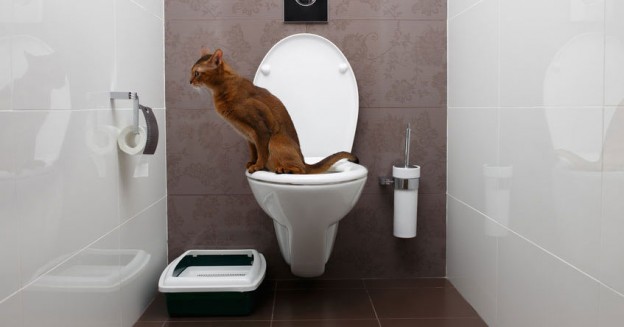Never Flush Cat Poop Down Your Toilet - Safeguard Your Pipes System
Never Flush Cat Poop Down Your Toilet - Safeguard Your Pipes System
Blog Article
Just how do you really feel in relation to Can You Flush Cat Poop Down The Toilet??

Introduction
As feline proprietors, it's important to bear in mind how we get rid of our feline close friends' waste. While it may appear hassle-free to purge feline poop down the toilet, this method can have damaging effects for both the environment and human health.
Alternatives to Flushing
Luckily, there are more secure and more responsible methods to take care of cat poop. Think about the complying with options:
1. Scoop and Dispose in Trash
One of the most usual approach of dealing with cat poop is to scoop it into a naturally degradable bag and toss it in the trash. Be sure to use a committed clutter inside story and get rid of the waste immediately.
2. Usage Biodegradable Litter
Select biodegradable cat trash made from materials such as corn or wheat. These litters are environmentally friendly and can be safely gotten rid of in the trash.
3. Bury in the Yard
If you have a yard, take into consideration burying feline waste in a marked area away from veggie yards and water resources. Make sure to dig deep sufficient to avoid contamination of groundwater.
4. Set Up a Pet Waste Disposal System
Purchase a pet garbage disposal system especially created for feline waste. These systems use enzymes to break down the waste, reducing smell and environmental impact.
Health Risks
Along with environmental concerns, purging feline waste can likewise pose wellness threats to humans. Cat feces might consist of Toxoplasma gondii, a parasite that can cause toxoplasmosis-- a possibly serious disease, specifically for expecting females and people with weakened body immune systems.
Ecological Impact
Flushing pet cat poop introduces hazardous virus and bloodsuckers right into the water system, positioning a significant danger to aquatic environments. These contaminants can adversely impact aquatic life and compromise water high quality.
Conclusion
Accountable pet ownership expands beyond providing food and sanctuary-- it additionally involves proper waste administration. By avoiding flushing feline poop down the toilet and choosing alternative disposal methods, we can decrease our environmental impact and protect human wellness.
Why Can’t I Flush Cat Poop?
It Spreads a Parasite
Cats are frequently infected with a parasite called toxoplasma gondii. The parasite causes an infection called toxoplasmosis. It is usually harmless to cats. The parasite only uses cat poop as a host for its eggs. Otherwise, the cat’s immune system usually keeps the infection at low enough levels to maintain its own health. But it does not stop the develop of eggs. These eggs are tiny and surprisingly tough. They may survive for a year before they begin to grow. But that’s the problem.
Our wastewater system is not designed to deal with toxoplasmosis eggs. Instead, most eggs will flush from your toilet into sewers and wastewater management plants. After the sewage is treated for many other harmful things in it, it is typically released into local rivers, lakes, or oceans. Here, the toxoplasmosis eggs can find new hosts, including starfish, crabs, otters, and many other wildlife. For many, this is a significant risk to their health. Toxoplasmosis can also end up infecting water sources that are important for agriculture, which means our deer, pigs, and sheep can get infected too.
Is There Risk to Humans?
There can be a risk to human life from flushing cat poop down the toilet. If you do so, the parasites from your cat’s poop can end up in shellfish, game animals, or livestock. If this meat is then served raw or undercooked, the people who eat it can get sick.
In fact, according to the CDC, 40 million people in the United States are infected with toxoplasma gondii. They get it from exposure to infected seafood, or from some kind of cat poop contamination, like drinking from a stream that is contaminated or touching anything that has come into contact with cat poop. That includes just cleaning a cat litter box.
Most people who get infected with these parasites will not develop any symptoms. However, for pregnant women or for those with compromised immune systems, the parasite can cause severe health problems.
How to Handle Cat Poop
The best way to handle cat poop is actually to clean the box more often. The eggs that the parasite sheds will not become active until one to five days after the cat poops. That means that if you clean daily, you’re much less likely to come into direct contact with infectious eggs.
That said, always dispose of cat poop in the garbage and not down the toilet. Wash your hands before and after you clean the litter box, and bring the bag of poop right outside to your garbage bins.
https://trenchlesssolutionsusa.com/why-cant-i-flush-cat-poop/

Do you appreciate reading about Don’t flush cat feces down the toilet? Try to leave a remark down below. We would be interested to hear your opinion about this write up. We are looking forward that you come back again before long. Sharing is nice. One never knows, you may just be doing someone a favor. Many thanks for your time. Please come by our blog back soon.
Book My Estimate Report this page